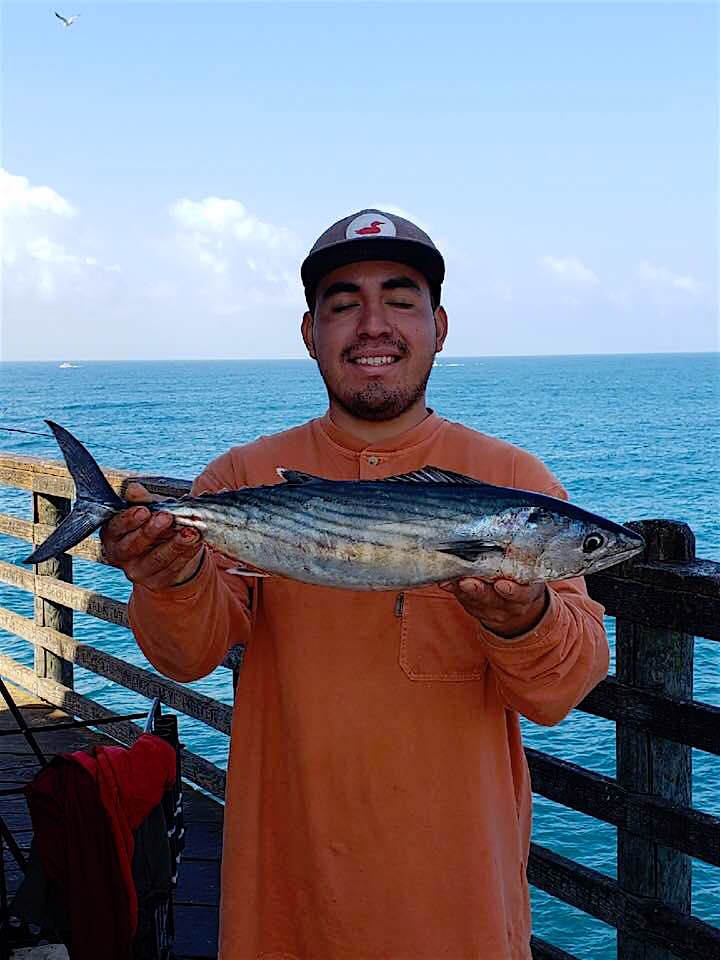
Bonito taken from the pier in 2018 (Picture courtesy of the Oceanside Pier Bait Shop)
Late summer to fall months will also see some barracuda, mid-pier to the end. Most of the barries show up at night and your best bet to catch them is generally a gold- or silver-colored spoon like a Kastmaster or Krocodile. Do be sure to check size regulations for the barriers since most will be undersized and should be returned, unharmed, back to the sea.
As mentioned, most years will see some yellowtail show up, usually in the August-October months, and most will be the smaller firecracker-size fish. That can change during El Niño, warm-water years. More fish will show up, the run can start earlier in the summer, and larger fish may also visit the pier. As example, during the El Niñoconditions in 2015 there was an extended run of yellows in September, mostly firecrackers but also some of the larger “tanker” size fish.
The rock quarry artificial reef out toward the end of the pier will attract salema and other rock-loving species. Unfortunately, people literally catch and keep enough of the small fish to fill buckets even though the limit is ten. Hopefully some of the people will face some stiff fines one of these days. A high low set up with size 6-8 hooks and a small piece of bait—worm, strip of squid, small piece of shrimp or even cut mackerel fished mid-depth will yield the salema.
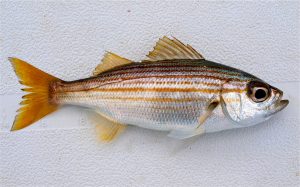
Salema
Winter months, usually at night, will see sculpin (California scorpionfish) showing up. They prefer a strip of squid or shrimp on a high/low rigging and are caught on the bottom. They are delicious to eat but be very careful in the handling since painful stings can occur from the long spines. If stung, hot water applied to the wound may provide some relief.
Another rock-loving species is sheephead and though fairly uncommon, quite a few of the fish have been caught out at the end of the pier. Included were some good-size sheepies (12 and 27 pounders in April 1998, a 32” fish guesstimated at 20 pounds in November 2002, and a 20+ pound fish in January of 2003). In most instances the bait was ghost shrimp or pieces of market shrimp although crabs and mussels are also good bait, and both bloodworms and live anchovies have been reported as successful baits at the pier. If you want to try to catch one of the big-toothed creatures be warned that they only feed during the daylight hours (they sleep at night) and are most common during the winter months.
Although not considered a great pier for sharks, enough are taken to keep the local sharay (shark and ray) fraternity busy. Most are caught at the end and regulars say a long cast out from the southeast corner of the pier gives the best chance for one of the bigger sharks. The usual suspects are encountered—leopard sharks, gray smoothhounds, spiny dogfish, shovelnose sharks (actually a guitarfish), bat rays and thresher sharks. Every so often a large 7-gill shark or soupfin shark will show up to keep things interesting.
Blue sharks occasionally wander in from deeper waters; mako sharks do the same at times. A mako estimated at 8 feet in length was lost at gaff in 2015; a 7-8 foot mako was landed in April of 2016. In warm water El Nino years it’s not unusual to see hammerhead sharks like the small one seen next to the pier in August 2015.
Increasingly, great whites are also showing up and though most are small juveniles, a pretty large one showed up in September of 2016 (and remember that it is illegal to take a great white). Another large shark, first reported as a great white, showed up in July 2015. As it turned out the approximately 12-foot long shark was simply a harmless basking shark (that strains plankton through its gills for food).
Best bait for most of the legal sharks is a large, bloody piece of mackerel while the threshers prefer a live mackerel on a sliding leader.
One of the larger sharays is shovelnose guitarfish usually simply called shovelnose sharks. Most that are caught are around the three foot size but occasionally fish approaching five feet in length will be caught.
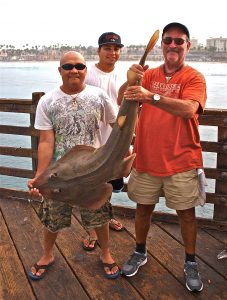
Shovelnose shark (guitarfish) taken in 2015
Generally the largest of the sharays will be big bat rays that are affectionately called “mud marlin” by the pier rat community. Most years can see bat rays being landed that exceed 80 pounds in weight; some years will see fish over the 100-pound mark (and they are always the old mama fish). One that weighed an estimated 150 pounds was taken in April of 2001 and another, guesstimated to weigh over 200 pounds, was caught in April of 2006. March of 2010 may have seen the greatest number of big fish when over a dozen bat rays exceeding a hundred pounds were taken (along with a plethora of small rays). The bat rays prefer squid for their meals although anglers sometimes try a potpourri of baits (including stuffing a squid with anchovies or other fish). Do remember that if you’re seeking out the big critters to bring a net and someone to help you with the net. It’s reported to be 32 feet up from the low water mark to the pier surface.
A somewhat special environment is found around the pilings, generally the pilings found mid-pier to the end. Certain fish stay close to and feed on the mussels, crabs, shrimp, and other food that lives on the pilings. Circling around the pilings, and usually near the top of the water are large pileperch. Down near the bottom or often a couple of feet from the bottom will be blackperch (aka buttermouth perch) and rubberlip seaperch. If you’re lucky you might even encounter a cabezon, which almost always hangs near the bottom of the pilings, often under mussels on the piling. Near the pilings, but generally found mid-pier more than toward the end are some opaleye and halfmoon. Both of the latter are good fighters and the opaleye in particular can reach pretty decent size.
When fishing around the pilings, try mussels, bloodworms, or ghost shrimp; use a bait holder-type hook for the bloodworms and mussels, a Kahle-type hook for the ghost shrimp. Oldsters would sometimes take a small clump of mussels, wrap a line with several small hooks in the mussels, and drop the whole clump down toward the mussel-encrusted pilings. The result can be some big perch. In addition, small sidewinder crabs make excellent bait for all of these fish; hook them under the rear part of their shell with a size 6 or 4 hook. A check of the inshore pilings under the pier can sometimes yield up some of these small crabs for bait.
Given the size of the pier, and the number of anglers, it’s not too surprising that some unusual fish may also show up at the pier.
A favorite Central California species but uncommon to Southern California piers is striped bass. Nevertheless, a 27” striped bass was taken in July ‘00 and another 37” striper taken in November 2015. A fish also common to the north but rarely seen at SoCal piers is grass rockfish but one was caught in April of 2015.
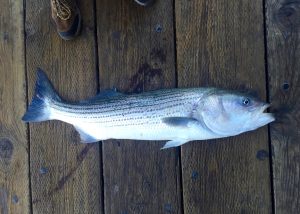
Striped bass taken in 2015 (Picture courtesy of the Oceanside Pier Bait Shop)
Although not really rare, basketweave cusk-eels (Ophidion scrippsae) are an infrequent catch from piers yet scientific records list at least two of the cusk-eels as being taken from the pier—in 1947 and 1966—and I’m pretty sure there have been more.
Bonefish (Cortez bonefish, Albula gilbert) have made occasional appearances. A 13-inch bonefish were taken in February of ‘01 and another was caught in August 2007. An earlier report from 1963 showed an even greater catch of the elusive bonefish:
John E. Fitch, research director of the DFG Marine Resources Operations on Terminal Island (reports) fishermen have been catching from one to a half-dozen bonefish daily off the Oceanside Pier. Either there has been a successful hatch in our waters in recent years or these fish have wandered north with a tongue of warm water in late September and October. —Donnell Culpepper, Fishin’ Around, Long Beach Press-Telegram, November 13, 1963
A fairly rare species taken at the pier was a deep-water lancetfish. Even more rare was a Pacific tripletail (Lobotes pacificus) caught in early October 2014. Typically found in the Sea of Cortez, and along the Pacific coast of Baja California south of Guerrero Negro, only a few of the fish have ever been taken in California waters. As evidence of the warm waters in 2014, another tripletail was taken in San Diego Bay in August of the same year.
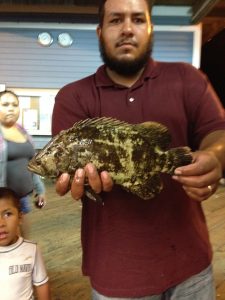
Tripletail
An unusual fish due to its size was a 9-pound kelp (calico) bass caught by a neophyte angler in September of ‘02. He rented a pole, bought some frozen squid, and headed out from the pier’s bait shop. A short time later he came back to the shop with the huge calico. Most anglers will fish a lifetime from a pier and never catch a 9-pounder (in fact, it’s a pretty good calico even from a boat).
A fish that was becoming rare, and was considered endangered just a couple of decades ago, is the giant (black) sea bass, a goliath of the sea that never fails to startle pier fishermen used to the smaller species. The earliest PFIC reports of a giant sea bass capture at Oceanside was a 143-pound fish that was hooked on Memorial Day Weekend in 1997. Three drops of a treble hook gaff were needed to snag the fish and then four people were needed to haul it up onto the pier. These bass are of course illegal and the smart move would have been to simply cut the line when the angler saw what it was. Instead, the determined angler headed up the pier dragging his catch behind him—only to meet a game warden coming down the pier. It was a TRULY DUMB act and the fine is around $2,000.
Then, in the fall of 2002, several were taken during September and October—including one that most of the regulars said would have topped 200 pounds if not released. May of 2003 saw a fish estimated at 150 pounds, a “giant” fish was caught on July 4, 2008, and a fish estimated at 200 pounds was seen in early June 2009. That fish was hooked on heavy line and wound up tangling the line around the pier’s pilings. Eventually the bait shop was able to contact lifeguards who swam out to the fish and cut the line allowing it to swim free (nice job!).
Huge black sea bass hooked in Oceanside
Raul Espinoza may think about Ernest Hemingway’s quote when he’s fishing for huge thresher shark on Oceanside Pier, but he never dreamed he’d catch something much larger. “My big fish must be somewhere,” Hemingway wrote in “The Old Man and the Sea.”
Espinoza hoped his big fish would be a huge mako shark that he has caught and lost three times, but earlier this week he hooked into a monster black sea bass that took him more than three hours to bring in. Because the fish is protected, he also carefully handled it to make sure it revived and returned to the deep.
Espinoza, 36, has been fishing on Oceanside Pier since he was 5 years old. He loves to fish for shark, often during the wee hours, and headed out last Saturday with that in mind…
On this night, he was out to catch mako shark. He used a whole mackerel on 40-pound line and a 50-pound leader. Just before 3 a.m., he started getting a nibble. “I know exactly what time it was because I had just looked at my watch at 2:50 a.m.,” Espinoza said. He expected a shark to be nibbling lightly. “I set the hook and it peeled out and started pulling line. I couldn’t stop it,” he said. He was sure this was the large mako weighing about 450 pounds that he hooked three times before. Each time he lost it. “I was taking my time, because this time I wanted to tire him out and not lose him,” Espinoza said. After stripping about 400 yards of line, he slowed down and Espinoza was able to lock down his drag and start cranking. “I was able to recover a couple hundred yards of line until he started running again. He did this seven times until I got him to the pier at 6 a.m.,” he said.
It was only then he realized he had hooked the protected fish. State law requires they be safely released… Once he realized this was a protected sea bass instead of a shark, it was a different ballgame. “Things changed once I knew I had the bass. It was now survival mode,” Espinoza said. “I had to make sure it survived.”The small crowd of night pier anglers had gathered to watch and was stunned by the size of the fish. They rooted Espinoza on.
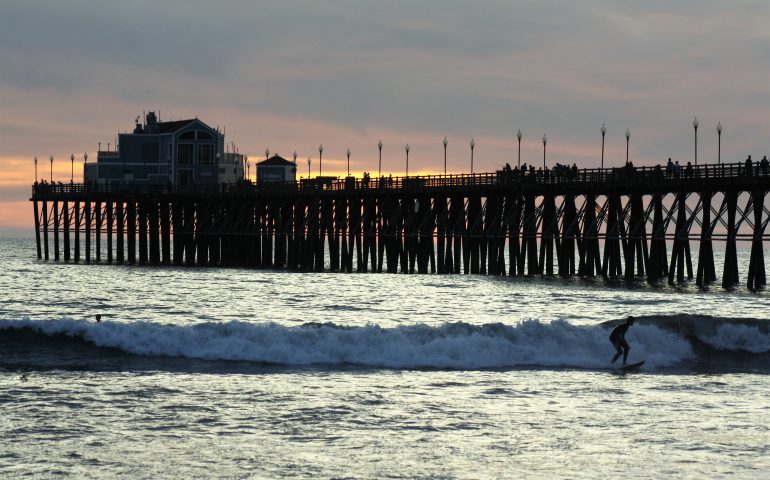
Always enjoy reading your articles Mr. Jones. I’ve been visiting Oceanside pier for close to 40
years, and enjoy your guide book for many years. Enjoyed some quiet fishing after midnight fishing
there– it’s too crowded at daytime! I had no idea that there was a proposal to close it down at night!
Yes, you’re right– it’s not a cheap place to visit anymore, but it’s still beautiful! Thank you very much,
and good fishing! With respects– Haik Goomroyan from Las Vegas.
Haik, Thank you for your kind comments. Ken